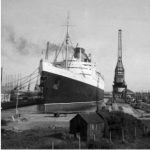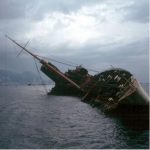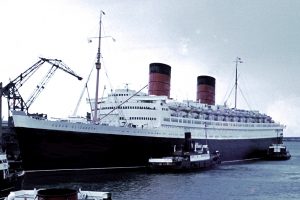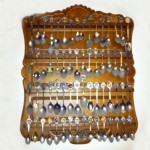Hong Kong
 One of the most elegant ships ever built, RMS Queen Elizabeth, was one of the two superliners built by John Brown and Company in Clydebank, Scotland, in the 1930s. The ship did not start out as RMS Queen Elizabeth, but rather as Hull 552. Later, it was named in honor of Queen Elizabeth, and launched, on 27 September 1938. The RMS Queen Elizabeth was 1,031 feet long and 118.5 feet wide. It was the largest passenger liner ever constructed…until then anyway.
One of the most elegant ships ever built, RMS Queen Elizabeth, was one of the two superliners built by John Brown and Company in Clydebank, Scotland, in the 1930s. The ship did not start out as RMS Queen Elizabeth, but rather as Hull 552. Later, it was named in honor of Queen Elizabeth, and launched, on 27 September 1938. The RMS Queen Elizabeth was 1,031 feet long and 118.5 feet wide. It was the largest passenger liner ever constructed…until then anyway.
During the late 1930s, workers at a Scottish construction site began building a sea vessel for the Cunard Line ocean liner company that would be larger and more luxurious than anything the world had ever seen. However, the outbreak of World War II in 1939 prevented the completion of the Queen Elizabeth‘s finer points. The vessel was hastily made seaworthy for wartime service and was used as a transport vessel for the Allies, carrying massive amounts of supplies and several hundred thousand troops around the world until the war’s end. Because of the concerns over German bombing, the ship was moved to New York to harbor it in a safer place.
After the war, the ship, which was equipped with a 200,000 horsepower engine, was embellished with an elegant art deco style. It made its public debut in 1946, leaving Southampton, England, on its first luxurious  run across the Atlantic. The ship continued to be a luxury passenger liner until it retirement in 1968.
run across the Atlantic. The ship continued to be a luxury passenger liner until it retirement in 1968.
Then, the Queen Elizabeth was auctioned off to the highest bidder, eventually being purchased in 1970 by C.W. Tung, a Taiwanese shipping tycoon. Tung renamed the vessel Seawise University and began work on converting the ship into a learning center that would tour the world. However, in early 1972, as the mobile university neared completion, a fire destroyed the pride of the Cunard Line. The fire broke out while the ship was docked in Hong Kong Harbor, and by the next morning the famous vessel was a total loss on the bottom of the sea floor.
 On September 27, 1938, the largest passenger ship of its time, the Queen Elizabeth, named after the wife of King George VI was launched. The ship was the epitome of luxury. And those fortunate enough to sail on it were treated to every luxury imaginable, at least until World War II came about. When World War II began, the Queen Elizabeth was sent to New York to protect it from German bombs. It was docked next to the Normandie and the Queen Mary, the other two largest passenger ships of the time. As the war progressed, the Queen Elizabeth was called into service as a troop transport ship. It carried nearly 1 million soldiers before the war ended. After the war, the ship returned to commercial service and became one of the dominant transatlantic carriers, hauling thousands of people back and forth between England and the United States. It was once again doing the work it was designed for.
On September 27, 1938, the largest passenger ship of its time, the Queen Elizabeth, named after the wife of King George VI was launched. The ship was the epitome of luxury. And those fortunate enough to sail on it were treated to every luxury imaginable, at least until World War II came about. When World War II began, the Queen Elizabeth was sent to New York to protect it from German bombs. It was docked next to the Normandie and the Queen Mary, the other two largest passenger ships of the time. As the war progressed, the Queen Elizabeth was called into service as a troop transport ship. It carried nearly 1 million soldiers before the war ended. After the war, the ship returned to commercial service and became one of the dominant transatlantic carriers, hauling thousands of people back and forth between England and the United States. It was once again doing the work it was designed for.
In 1968, the ship’s owner, the Cunard Steamship Company, sold the Queen Elizabeth. The purchasing company planned to make it a tourist attraction and hotel in Philadelphia. The plans were scrapped when the aging ship was deemed a fire hazard. Two years later it was sold to Hong Kong businessman CY Tung, who wanted to use the ship as a floating college. Tung renamed the ship, Seawise University and sent it to Hong Kong Harbor for refitting. On January 9, 1972, as the ship neared the completion of the £5 million conversion, it caught fire. The fire was thought by some to have been arson, because several blazes broke out simultaneously throughout the ship. The fact that CY Tung had acquired the vessel for $3.5 million, and had insured it for $8 million, led some to speculate that the inferno was part of a fraud to collect on the insurance claim. Others speculated that the  fires were the result of a conflict between Tung, a Chinese Nationalist, and Communist-dominated ship construction unions. Virtually, the entire Hong Kong firefighting force turned out to try to save the ship, but despite their heroic efforts over two long days, the ship turned on its side and sank to the bottom of the harbor, which was apparently not very deep, because over half of the ship could be seen above the water until it was dismantled and sold for scrap between 1974 and 1975, because it had been deemed a shipping hazard. Fortunately, no one was killed in the fire. Shortly before it was scrapped, the wreck served as the backdrop for a key scene in The Man With the Golden Gun, a 1974 James Bond film starring Roger Moore.
fires were the result of a conflict between Tung, a Chinese Nationalist, and Communist-dominated ship construction unions. Virtually, the entire Hong Kong firefighting force turned out to try to save the ship, but despite their heroic efforts over two long days, the ship turned on its side and sank to the bottom of the harbor, which was apparently not very deep, because over half of the ship could be seen above the water until it was dismantled and sold for scrap between 1974 and 1975, because it had been deemed a shipping hazard. Fortunately, no one was killed in the fire. Shortly before it was scrapped, the wreck served as the backdrop for a key scene in The Man With the Golden Gun, a 1974 James Bond film starring Roger Moore.
 When I was a young girl, our family took a vacation every year. By the time I was 12 years old, I had every possible worthless souvenir there was. It was at that point that I decided to change the plan some. I told my mom that instead of the silly souvenirs, I was going to start buying something that would have meaning for the rest of my life. She thought that was a great idea. So I looked around the souvenir store that we were in at Grand Coulee Dam, and found my first spoon. The decision…made by a 12 year old girl…began a lifelong collection for me.
When I was a young girl, our family took a vacation every year. By the time I was 12 years old, I had every possible worthless souvenir there was. It was at that point that I decided to change the plan some. I told my mom that instead of the silly souvenirs, I was going to start buying something that would have meaning for the rest of my life. She thought that was a great idea. So I looked around the souvenir store that we were in at Grand Coulee Dam, and found my first spoon. The decision…made by a 12 year old girl…began a lifelong collection for me.
At first I kept my collection in a box, but later on that was going to be problematic. The spoons would be hard to enjoy, because they could only be looked at when I had time to go through the box, and no one else could really enjoy my collection. It was at that time that I came across the only souvenir I would buy during those years that was not a spoon. It was my first spoon rack, and it was beautiful as you can see.
When I first bought the spoon rack, it didn’t have very many spoons on it, but the years  have changed that. I have added many spoons from places that are very special to me. I have also been given spoons from all over the world, as friends and family members traveled to those places and were kind enough to spend their time to look for a spoon for me. I have spoons from places like the Statue of Liberty, the Golden Gate Bridge, the Space Needle, and the Grand Canyon, all of which I have had the privilege of seeing. I collected spoons from every state that I have been in. I have also collected many memories with each of those spoons.
have changed that. I have added many spoons from places that are very special to me. I have also been given spoons from all over the world, as friends and family members traveled to those places and were kind enough to spend their time to look for a spoon for me. I have spoons from places like the Statue of Liberty, the Golden Gate Bridge, the Space Needle, and the Grand Canyon, all of which I have had the privilege of seeing. I collected spoons from every state that I have been in. I have also collected many memories with each of those spoons.
Then, as more of the people I knew began to travel out of the country, me spoon collection grew in ways I never expected. My ex-brother-in-law, Warren, who has remained a friend of the family since my sister’s divorce, contributed a great many of those out of the country spoons. Warren was in the Navy, and was required to go on cruises for long periods of times to many places around the world. Warren brought back spoons from Thailand, Hong Kong, Spain, Jerusalem, and Rome. My grandmother brought me one from Ireland when she got got go there…it was the trip of a lifetime for her, and that spoon reminds me of how much fun she had. My boss, Jim brought me a spoon from Israel when he and his wife  Julie went there for their 25th wedding anniversary. These gifted spoons have a memory all their own for me, because while they are from places I have never been, I have the joy of knowing what each trip meant to the person who took it. Some were so special that they were the highlight of the travelers life. And they took time to do something nice for me.
Julie went there for their 25th wedding anniversary. These gifted spoons have a memory all their own for me, because while they are from places I have never been, I have the joy of knowing what each trip meant to the person who took it. Some were so special that they were the highlight of the travelers life. And they took time to do something nice for me.
My collection will continue to grow as I travel and others do. In fact, the collection as grown so much that I have had to add a second spoon rack, just to hold them all. It is almost like having a scrapbook that hangs on my wall. My spoons have their own stories to tell.

